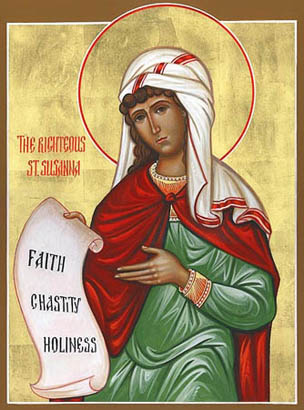
The Holy Martyress Susanna the Virgin
Commemorated on August 11
The Holy Martyress Susanna the Virgin was the daughter of Presbyter Gavinius and a niece of the Holy Pope of Rome Caius (283-296). She was raised in strict Christian piety and in her youthful years dedicated herself to God. The family of the saint occupied a position of kinship with the emperor Diocletian (284-305), to whom there reached reports about her virtue and beauty. Having decided to give Saint Susanna in marriage to his co‑ruling emperor Maximian Hercules (284-305), the emperor sent to presbyter Gavinius his own kinsman the dignitary Claudius, and then his own brother Maximus. Both of them together with the wife of Claudius Prepedigna and her sons Alexander and Cythius – after conversation with the pious family accepted Baptism. Having learned of this, that the entire family of the imperial kinsfolk had been converted to Christianity, Diocletian sent them into exile. Soon they burned the martyrs at Ostia, not far from Rome, and threw the ashes into the sea. They took the holy virgin Susanna to the palace, and the empress was entrusted to persuade her to submit. But the empress, secretly a Christian, supported the martyress in her intention to preserve her virginity for the sake of the Lord. She explained to the emperor about the unwillingness of the virgin to enter into marriage with a pagan. Diocletian gave permission to his co-ruler to dishonour the holy virgin, but an Angel defended her. [here apparently is a lacuna] Macedonius began to urge the martyress to offer sacrifice to the idols. "I offer myself in sacrifice to my Lord", – she answered. Then Macedonius cut off the head of the martyress. The empress secretly buried the body of the saint; the room, where the murder occurred, was consecrated into a church by Holy Pope Caius. Soon the father of Saint Susanna – Presbyter Gavinius – accepted a martyr's end, as also in the year 296 did Sainted Caius.

© 1996-2001 by translator Fr. S. Janos.